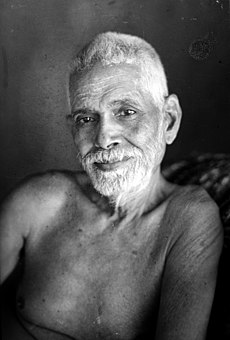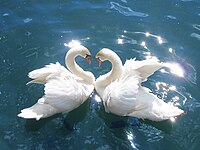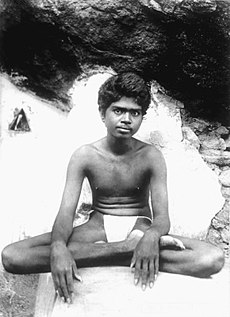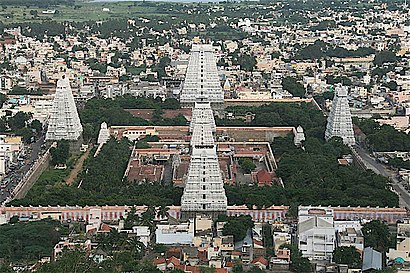Jump to navigation Jump to search
| Ramana Maharshi | |
|---|---|

Sri Ramana Maharshi in his late 60s.
| |
| Religion | Hinduism |
| Philosophy | Advaita Vedanta |
| Personal | |
| Nationality | Indian |
| Born |
Venkataraman Iyer 30 December 1879 Tiruchuzhi, Madras, India |
| Died |
14 April 1950 (aged 70) Sri Ramana Ashram, Tiruvannamalai, Tamilnadu, India |
| Guru | Arunachala |
| Literary works |
Nān Yār? ("Who am I?") Five Hymns to Arunachala |
Quotation
Of all the thoughts that rise in the mind, the thought 'I' is the first thought.
| Part of a series on |
| Advaita |
|---|
 |
| Part of a series on | ||
| Hindu philosophy | ||
|---|---|---|
 | ||
| Orthodox | ||
|
||
| Heterodox | ||
|
|
||
He was born in what is now Tiruchuli, Tamil Nadu, India. In 1895, an attraction to the sacred hill Arunachala and the 63 Nayanars was aroused in him,[4] and in 1896, at the age of 16, he had a "death-experience" where he became aware of a "current" or "force" (avesam) which he recognised as his true "I" or "self",[web 1][5] and which he later identified with "the personal God, or Iswara,"[web 1][note 2] that is, Shiva. This resulted in a state that he later described as "the state of mind of Iswara or the jnani".[web 1][note 3] Six weeks later he left his uncle's home in Madurai, and journeyed to the holy mountain Arunachala, in Tiruvannamalai, where he took on the role of a sannyasin (though not formally initiated), and remained for the rest of his life.
He soon attracted devotees who regarded him as an avatar and came to him for darshan ("the sight of God"), and in later years an ashram grew up around him, where visitors received upadesa ("spiritual instruction")[7] by sitting silently in his company asking questions.[8] Since the 1930s his teachings have been popularized in the West, resulting in his worldwide recognition as an enlightened being.[9]
Ramana Maharshi approved a number of paths and practices,[3] but recommended self-enquiry as the principal means to remove ignorance and abide in Self-awareness,[web 2][10] together with bhakti (devotion) or surrender to the Self.[web 2]
Early years (1879–1895)
Temple of Tiruchuzhi, Tamil Nadu
Both a paternal uncle of his father and his father's brother had become sannyasins.[12] Venkataraman's family belonged to the Smarta denomination, and regular worship of Lord Siva, Lord Vishnu, Lord Ganesa, Lord Surya and Goddess Shakti took place in their home.[13][14]
When Venkataraman was seven he had his upanayana,[15] the traditional initiation of the three upper varnas into Brahmanical learning and the knowledge of Self. He had a very good memory, and was able to recall information after hearing it once, an ability he used to memorise Tamil poems.[15]
Narasimha notes that Venkataraman used to sleep very deeply, not waking up from loud sounds, nor even when his body was beaten by others.[16][17] When he was about twelve years old, he may have experienced spontaneous deep meditative states. Sri Ramana Vijayam, the Tamil biography that first appeared in the 1920s, describes a period a few years before the death-experience in Madurai:
Some incomplete practice from a past birth was clinging to me. I would be putting attention solely within, forgetting the body. Sometimes I would be sitting in one place, but when I regained normal consciousness and got up, I would notice that I was lying down in a different narrow space [to the one where I had first sat down].[note 4]When he was about eleven his father sent him to live with his paternal uncle Subbaiyar in Dindigul as he wanted his sons to be educated in the English language so that they would be eligible to enter government service. Only Tamil was taught at the village school in Tiruchuzhi,[15] which he attended for three years.[18] In 1891, when his uncle was transferred to Madurai, Venkataraman and his elder brother Nagaswami moved with him. In Dindigul, Venkataraman attended a Hindu School where English was taught,[15] and stayed there for a year.[18]
His father, Sundaram Iyer, died suddenly on 18 February 1892.[19] After his father's death, the family split up; Venkataraman and Nagaswami stayed with Subbaiyar in Madurai.[12]
Adolescence and awakening (1895–1896)
Venkataraman as a young man.
In November 1895 Venkataraman realized that Arunachala, the sacred mountain, was a real place.[21] He had known of its existence from an early age, and was overwhelmed by the realisation that it really existed.[21] During this time he also read Sekkizhar's Periyapuranam, a book that describes the lives of the 63 Nayanars, which "made a great impression" on him,[22][web 3] and revealed to him that "Divine Union" is possible.[21] According to Osborne, a new current of awareness started to awaken during his visits to the Meenakshi Temple at Madurai, "a state of blissful consciousness transcending both the physical and mental plane and yet compatible with full use of the physical and mental faculties".[23]
According to Narasimha, in July 1896,[22][note 5] at age 16, a sudden fear of death befell him. He was struck by "a flash of excitement" or "heat," like some avesam, a "current" or "force" that seemed to possess him,[web 1] while his body became rigid. He initiated a process of self-enquiry asking himself what it is that dies. He concluded that the body dies, but that this "current" or "force" remains alive, and recognised this "current" or "force" as his Self, which he later identified with "the personal God, or Iswara".[web 1][note 2]
In one of his rare written comments on this process Ramana Maharshi wrote, "Enquiring within Who is the seer? I saw the seer disappear leaving That alone which stands forever. No thought arose to say I saw. How then could the thought arise to say I did not see."[web 5]
Later in life, he called his death experience akrama mukti, "sudden liberation," as opposed to the krama mukti, "gradual liberation" as in the Vedanta path of jnana yoga.[web 3][note 6] It resulted in a state of mind which he later described as "the state of mind of Iswara or the jnani:"[web 1]
After reading the language of the sacred books, I see it may be termed suddha manas [pure mind], akhandakara vritti [unbroken experience], prajna [true knowledge] etc.; that is, the state of mind of Iswara or the jnani."[web 1]After this event, he lost interest in school studies, friends, and relations. He was absent-minded at school, "imagining and expecting God would suddenly drop down from Heaven before me".[web 3] Avoiding company, he preferred to sit alone, absorbed in concentration on this current or force,[29] and went daily to the Meenakshi Temple, ecstatically devoted to the images of the 63 Nayanars and of Nataraja, wanting "the same grace as was shown to those saints,"[web 3] praying that he "should have the same bhakti that they had"[web 3] and "[weeping] that God should give me the same grace He gave to those saints".[web 3][11][note 7]
Knowing his family would not permit him to become a sanyassin and leave home, Venkataraman slipped away, telling his brother he needed to attend a special class at school.[31] Venkataraman boarded a train on 1 September 1896 and traveled to Tiruvannamalai where he remained for the rest of his life.[citation needed]
Tiruvannamalai temples (1896–1899)
Arunachaleswara temple (1896–1897)
On arriving in Tiruvannamalai, Maharshi went to the temple of Arunachaleswara.[32] The first few weeks he spent in the thousand-pillared hall, then shifted to other spots in the temple, and eventually to the Patala-lingam vault so that he might remain undisturbed. There, he spent days absorbed in such deep samādhi that he was unaware of the bites of vermin and pests. Seshadri Swamigal, a local saint, discovered him in the underground vault and tried to protect him.[31] After about six weeks in the Patala-lingam, he was carried out and cleaned up. For the next two months he stayed in the Subramanya Shrine, so unaware of his body and surroundings that food had to be placed in his mouth or he would have starved.Gurumurtam temple (1897–1898)
In February 1897, six months after his arrival at Tiruvannamalai, Ramana moved to Gurumurtam, a temple about a mile away.[33] Shortly after his arrival a sadhu named Palaniswami went to see him.[34] Palaniswami's first darshan left him filled with peace and bliss, and from that time on he served Ramana as his permanent attendant. Besides physical protection, Palaniswami would also beg for alms, cook and prepare meals for himself and Ramana, and care for him as needed.[35] In May 1898 Ramana moved to a mango orchard next to Gurumurtam.[36]Osborne wrote that during this time Ramana completely neglected his body.[35] He also ignored the ants which bit him incessantly.[33] Gradually, despite Ramana's desire for privacy, he attracted attention from visitors who admired his silence and austerities, bringing offerings and singing praises. Eventually a bamboo fence was built to protect him.[33]
While living at the Gurumurtam temple his family discovered his whereabouts. First, his uncle Nelliappa Iyer came and pleaded with him to return home, promising that the family would not disturb his ascetic life. Ramana sat motionless and eventually his uncle gave up.[37]
In September, 1898 Ramana moved to the Shiva-temple at Pavalakkunru, one of the eastern spurs of Arunachala. He refused to return even though his mother begged him to.[38]
Arunachala (1899–1922)
Soon after this, in February 1899, Ramana left the foothills to live on Arunachala itself.[39] He stayed briefly in Satguru Cave and Guhu Namasivaya Cave before taking up residence at Virupaksha Cave for the next 17 years, using Mango Tree cave during the summers, except for a six-month period at Pachaiamman Koil during the plague epidemic.[40]In 1902, a government official named Sivaprakasam Pillai, with writing slate in hand, visited the young Swami in the hope of obtaining answers to questions about "How to know one's true identity". The fourteen questions put to the young Swami and his answers were Ramana's first teachings on Self-enquiry, the method for which he became widely known, and were eventually published as Nan Yar?, or in English, Who am I?.[41]
Many visitors came to him and some became his devotees. Kavyakantha Sri Ganapati Sastri,[note 8] a Vedic scholar of repute in his age, with a deep knowledge of the Srutis, Sastras, Tantras, Yoga, and Agama systems, but lacking the personal darshan of Shiva,[42] came to visit Ramana in 1907. After receiving upadesa from him on self-enquiry, he proclaimed him as Bhagavan Sri Ramana Maharshi. Ramana was known by this name from then on.[43] Ganapati Sastri passed on these instructions to his own students, but later in life confessed that he had never been able to achieve permanent Self-abidance. Nevertheless, he was highly valued by Ramana Maharshi and played an important role in his life.[42]
In 1911 the first westerner, Frank Humphreys, then a police officer stationed in India, discovered Ramana and wrote articles about him which were first published in The International Psychic Gazette in 1913.[44][note 9]
In an appendix to Self realisation Narasimha wrote that in 1912, while in the company of disciples, Ramana had an epileptic fit, in which his vision was suddenly impaired three times by a "white bright curtain" which covered a part of his vision. At the third instance his vision was shut out completely, while his "head was swimming," and he felt his heart stop beating and his breathing seizing, while his skin turned blue, as if he was dead. This lasted for about ten or fifteen minutes, whereafter "a shock passed suddenly through the body," and his blood circulation and his respiration returned.[45] In response to "strange accounts" about this event, he later said that it was a fit, which he used to have occasionally, and did not bring on himself.[46] According to Osborne, it "marked the final completion of Sri Bhagavan’s return to full outer normality".[47]
In 1916 his mother Alagammal and younger brother Nagasundaram joined Ramana at Tiruvannamalai and followed him when he moved to the larger Skandashram Cave, where Bhagavan lived until the end of 1922. His mother took up the life of a sannyasin and Ramana began to give her intense, personal instruction, while she took charge of the Ashram kitchen. Ramana's younger brother, Nagasundaram, then became a sannyasi, assuming the name Niranjanananda, becoming known as Chinnaswami (the younger Swami).
During this period, Ramana composed The Five Hymns to Arunachala, his magnum opus in devotional lyric poetry. The first hymn is Akshara Mana Malai.[translation 1] It was composed in Tamil in response to the request of a devotee for a song to be sung while wandering in the town for alms. The Marital Garland tells in glowing symbolism of the love and union between the human soul and God, expressing the attitude of the soul that still aspires.[citation needed]
Starting in 1920, his mother's health deteriorated. She died on 19 May 1922 while Ramana sat beside her.[citation needed]
The Entrance of Sri Ramanasramam.
Sri Ramanasramam (1922–1950)
Commencement of Ramanasramam (1922-1930)
From 1922 until his death in 1950 Ramana lived in Sri Ramanasramam, the ashram that developed around his mother's tomb.[48] Ramana often walked from Skandashram to his mother's tomb. In December 1922 he did not return to Skandashram, and settled at the base of the Hill, and Sri Ramanasramam started to develop. At first, there was only one hut at the samadhi, but in 1924 two huts, one opposite the samadhi and the other to the north, were erected. The so-called Old Hall was built in 1928. Ramana lived there until 1949.[49]Sri Ramanasramam grew to include a library, hospital, post-office and many other facilities. Ramana displayed a natural talent for planning building projects. Annamalai Swami gave detailed accounts of this in his reminiscences.[50] Until 1938, Annamalai Swami was entrusted with the task of supervising the projects, and received his instructions from Ramana directly.
Sri Ramana led a modest and renunciate life. However, according to David Godman, who has written extensively about Ramana, a popular image of him as a person who spent most of his time doing nothing except sitting silently in samadhi is highly inaccurate. From the period when an Ashram began to rise around him after his mother arrived, until his later years when his health failed, Ramana was actually quite active in Ashram activities such as cooking and stitching leaf plates.[web 7]
Discovery by westerners (1930-1940)
In 1931 a biography of Ramana Maharshi, Self Realisation: The Life and Teachings of Ramana Maharshi, written by B. V. Narasimha, was published.[51] Ramana then became relatively well known in and out of India after 1934 when Paul Brunton, having first visited Ramana in January 1931, published the book A Search in Secret India.[52] In this book he describes how he was compelled by the Paramacharya of Kanchi to meet Ramana Maharshi, his meeting with Ramana Maharshi, and the effect this meeting had on him. Brunton also describes how Ramana's fame had spread, "so that pilgrims to the temple were often induced to go up the hill and see him before they returned home."[53] Brunton calls Ramana "one of the last of India's spiritual supermen,"[54] and describes his affection toward Ramana:I like him greatly because he is so simple and modest, when an atmosphere of authentic greatness lies so palpably around him; because he makes no claims to occult powers and hierophantic knowledge to impress the mystery loving nature of his countrymen; and because he is so totally without any traces of pretension that he strongly resists every effort to canonize him during his lifetime.[55]While staying at Sri Ramanasramam, Brunton had an experience of a "sublimely all-embracing" awareness,[56] a "Moment of Illumination".[57] The book was a best-seller, and introduced Ramana Maharshi to a wider audience in the west.[51] Resulting visitors included Paramahansa Yogananda, Somerset Maugham (whose 1944 novel The Razor's Edge models its spiritual guru after Ramana),[web 8] Mercedes de Acosta and Arthur Osborne, the last of whom was the first editor of Mountain Path in 1964, the magazine published by Ramanasramam.
Final years (1940-1950)
Sri Ramana Maharshi Mahanirvana in Ramanasramam
Devotion
Sri Ramana Maharshi reclining in the Old Hall where he lived from 1927 to 1950
Darshan and prasad
Many devotees visited Ramana Maharshi for darshan,[62] the sight of a holy person or God incarnate, which is advantageous and transmits merit.[63][64] According to Flood, in Indian religions the guru is akin to the image or statue of a deity in the temple, and both possess power and a sacred energy.[63] According to Osborne, Ramana Maharsi regarded giving darshan as "his task in life," and said that he had to be accessible to all who came.[62] Even during his terminal illness at the end of his life, he demanded to be approachable for all who came for his darshan.[62]Objects being touched or used by him were highly valued by his devotees, "as they considered it to be prasad and that it passed on some of the power and blessing of the Guru to them".[65] People also tried to touch his feet,[66] which is also considered darshana.[67] When one devotee asked if it would be possible to prostrate before Sri Ramana and touch his feet, he replied:
The real feet of Bhagavan exist only in the heart of the devotee. To hold onto these feet incessantly is true happiness. You will be disappointed if you hold onto my physical feet because one day this physical body will disappear. The greatest worship is worshipping the Guru's feet that are within oneself.[68]In later life, the number of devotees and their devotion grew so large that Ramana became restricted in his daily routine.[69] Measures had to be taken to prevent people touching him.[70] Several times Ramana tried to escape from the ashram, to return to a life of solitude. Vasudeva reports: "Bhagavan sat on a rock and said with tears in his eyes that he would never again come to the Ashram and would go where he pleased and live in the forests or caves away from all men."[71]
Ramana did return to the ashram, but has also reported himself on attempts to leave the ashram:
I tried to be free on a third occasion also. That was after mother's passing away. I did not want to have even an Ashram like Skandashram and the people that were coming there then. but the result has been this Ashram [Ramanashram] and all the crowd here. Thus all my three attempts failed.[71]
Avatar
Some of Ramana Maharshi's devotees regarded him to be as Dakshinamurthy;[72][73] as an avatar of Skanda, a divine form of Shiva popular in Tamil Nadu; as an incarnation of Jnana Sambandar, one of the sixty-three Nayanars; and as an incarnation of Kumārila Bhaṭṭa, the 8th century Mimamsa-philosopher. According to Krishna Bhikshu, one of his early biographers:As Kumarila he established the supremacy of the karma marga, as Jnana Sambandar, a poet, he brought bhakti marga close to the people and as Ramana he showed that the purpose of life was to abide in the Self and to stay in the sahaja state by the jnana marga.[74]







No comments:
Post a Comment